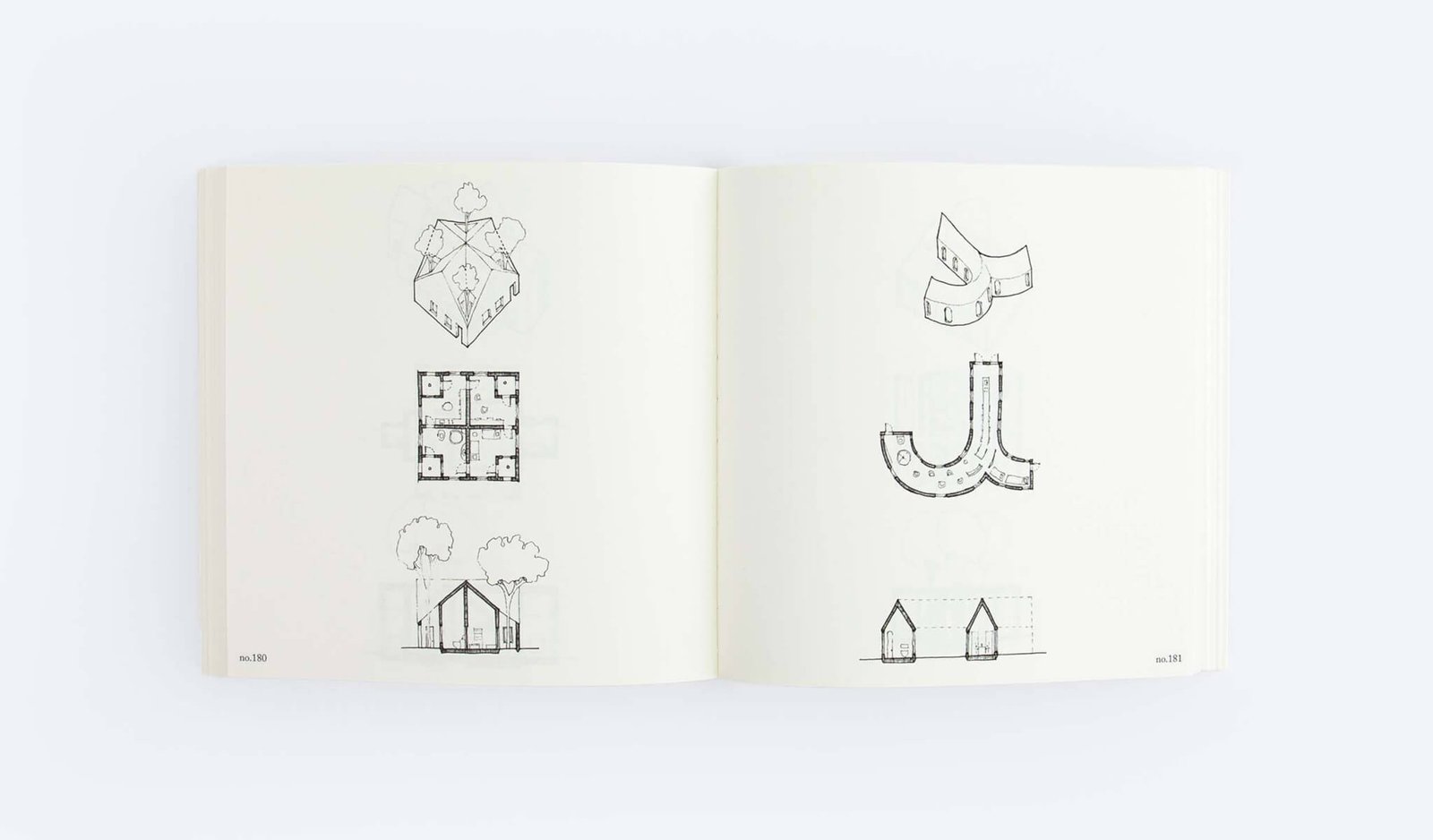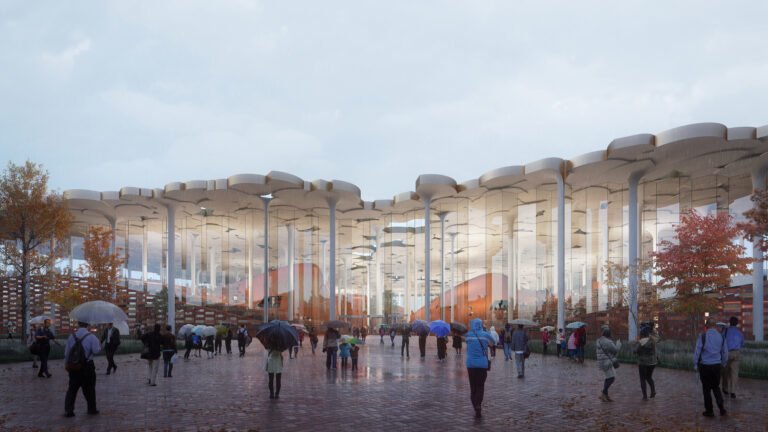One House Per Day documents a year’s worth of architect Andrew Bruno’s daily residential drawings
One House Per Day
Andrew Bruno | ORO Editions | $39.95
Working in series—making one thing, then another—can be grueling. It requires returning to the same operations to find emergent directions. Producing a series of a few dozen is hard enough, which is why architect Andrew Bruno’s study of a few hundred distinct houses is such an accomplishment. Bruno’s One House Per Day documents a year’s worth of daily house drawings. Each of the 365 houses is represented in a hand-sketched plan, section, and perspectival drawing, a stack of 1,095 drawings over the year.
In addition to the drawings, One House Per Day contains essays contextualizing Bruno’s houses politically and formally. The foreword by Keith Krumwiede celebrates the rigor intrinsic in Bruno’s collection of houses and the provocation inherent in the three-hundred and sixty-five specific studies that individually challenge programs and narratives around rituals of domestic life.

In Bruno’s exercises, rooms are the major compositional elements. They are combined and recombined in collages made in pursuit of novelty or unique forms. Rooms are transformed as they are copied into grids, stretched, bent, mirrored, elongated, shifted, nested, or stuffed into poché spaces. In plan and section, rooms are allocated furniture for scale and to suggest intentions for spatial use.
Some houses, like the gridded, open House No. 141, rely on the furniture more than walls to suggest use or forms of inhabitation. As an example, House no. 246 appears preoccupied with the quality of its large private upper bedroom as it contrasts a more public ground floor which spills into its context.
Other houses frustrate plan and section drawings and as such are best understood by reading plan, section, and perspective in concert. Reading House no. 313 requires considering, plan, section, and perspective separately as they all reveal separate aspects of the house. In plan, No. 313 is open save for thickened walls. In section, it’s revealed that those walls support thickened vaulting space in the roof, and in perspective, we see the light wells that capture light that would filter down into House no. 313. In these moments, Bruno’s houses surprise those interpreting them by asking us to fill in the gaps the drawings don’t illuminate. These openings seem to be the point, as Bruno’s houses are intended to open up questions about ways we live together through the rooms, furniture, interior-to-exterior relationships, and a latent questioning of inhabitation norms when unpacking each scribble. What forms of family might best thrive in these daydreams?

While Bruno set out with the “basic proposition that the detached house is a valid object for architects’ critical attention and earnest engagement,” a tenant that now might land as circumspect for the reason of carbon emissions, the book nevertheless offers meditations on modes of dwelling that transgress the forms of typical suburban accommodations. Bruno’s reflection at the end of One House Per Day calls out the nuclear family as something he attempted to frustrate by offering a few hundred other ways to think about collective living.

Clark Thenhaus’s included essay, “One Sentence Per Day,” reimagines Bruno’s daily drawing exercise as one in which the author scrawled one sentence daily for two weeks. Thenhaus’s one-sentence exercise, when read together, reads somewhere between an essay and journal entries, which celebrate the cleaving of formal and spatial value systems from social, cultural, and political systems as well as bemoans the act of writing a sentence a day as too disjunctive to form a coherent essay.
Essays that meditate on the political, social, and cultural history of single-family homes and what living collectively might offer in lieu of a nuclear family sandwich Bruno’s archive. In “Transcending the American Dream: House, Family, and Domesticity,” Alessandro Orisini and Nick Roseboro from Architensions, who also participated in One House Per Day as guest artists, discuss an abridged history of single-family homes as an individualistic, capitalist enterprise with racist roots. The construction of these homes has always been to isolate the family from outside activities, they argue. In “(Re)Thinking the House and its Family,”
Malcom Rio disentangles the family from patrilineal and monogamous structures and explores the construction of collective interpersonal relationships and spaces outside the nuclear family. Rio argues in his piece that the rise of the single-family house, capital, patrilineal society, and monogamy might be historically linked. Rio’s article points to the nuclear family as something represented as timeless and absolute but that is ultimately historical, and thus new family structures and methods for cohabitation are worth exploring.
Bruno’s opinion on these ideas goes unwritten. Working in series, drawing houses for a year must have imparted him with some elevated understanding of the typology, but he refrains from asserting a normative idea of what a house should be. The houses in One House Per Day, conceived of in response to standardization and the single-family home, invite readers to come to their own conclusion about which houses and styles of living suits them best. By considering the sociopolitical history of dwelling and provoking the discovery of new associations between form, use, and inhabitation, the project imagines a future where we might live together anywhere, as the drawings, save for some bubbled trees, don’t contain any context or topography.
In this study, readers witness how as the shape of the house contorts, a series of other slippages occur: Furniture arrangements shift, rooms produce different associations, and relationships among imagined inhabitants change. As these relations morph across a year of unique houses, readers realize they are explorers on an extended but focused homes tour, one that is not about fixtures and finishes but more a search for encloses to protect many possible collective futures.

Since Bruno’s three-hundred and sixty-fifth house, a handful of guest artists have stepped in to continue the series online, offering new and sometimes radically different interpretations of domestic space and representation styles. Some like Architensions and Freddo Daneshvaran maintain the essence of Bruno’s graphic style, while playing through their formal predilections in plan, section, and perspective. Others like Kemetic Blue and Stephanie Jazmines introduce color and shifting scalar elements that distort space and challenge readings of house forms. The guest series elevate One House Per Day from the project of an individual into a project of collective imagination. Adding new and diverse perspectives is a logical next step for a practice interested in envisioning novel, progressive forms of domestic life.
Charles Weak is a writer and an architect at ZGF Architects.




